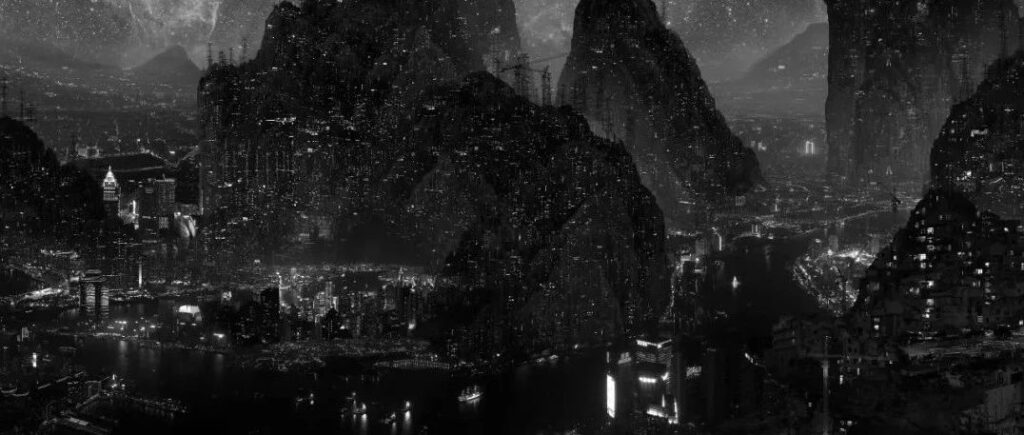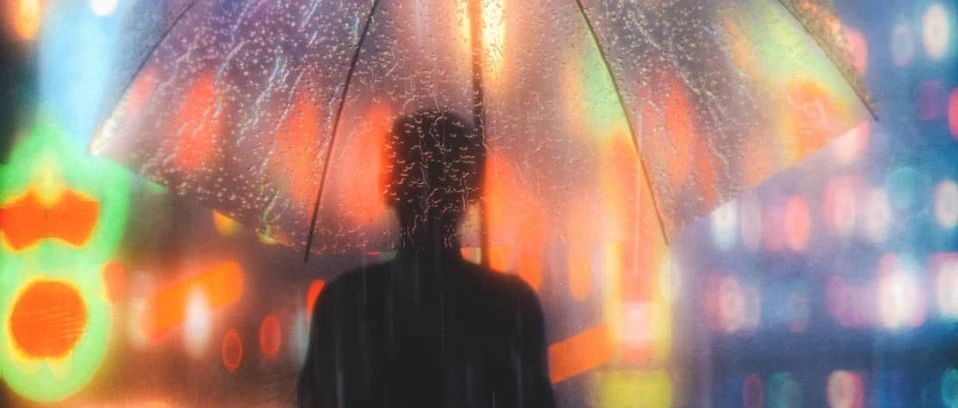
“Riverside Scene at Qingming Festival” by Zhang Zeduan
张择端的《清明上河图》
Known as one of China’s most renowned artworks from ancient history, “Riverside Scene at Qingming Festival”, portrays a highly complex look into Chinese culture. This panoramic painting by Zhang Zeduan accurately depicts the minute details of China during the Northern Song Dynasty. As an artwork, it carries significant value not only to the perseverance of Chinese art but also to China’s culture. Such aspects of traditional Chinese painting, among others, became the motivation for Yang Yongliang’s majestic landscape scroll paintings.
“清明上河图”作为中国古代历史上最著名的艺术品之一,用极其丰富的元素展现了中国的文化。张择端的这幅全景画精准地描绘了北宋时期中国的城市面貌和当时社会各阶层的生活状况。作为艺术品,它不仅对于中国文化具有重要的意义,同时承载着中华艺术的流传。传统国画的这些魅力激发了杨泳梁创作大型山水画卷的热情。

“In the future, we’ll only be able to see traditional Chinese art and calligraphy in museums because the structure of our current living conditions and changing cityscape won’t allow this art form to survive. So I’ve always been wondering how to show Chinese art in a new way”
“将来,我们只能在博物馆中看到中国的传统艺术和书法艺术,因为我们目前的生活方式和不断变化的城市景观将使这些艺术形式无法生存下去。所以我一直想探索如何以新的方式展示中华艺术”
– Yang Yongliang 杨泳梁



Moonlight Series 《月光》系列
Yang Yongliang uses mixed media such as painting, video, photo manipulation, and animation to create colossal landscapes that lure viewers’ interest. While his work employs a mix of both traditional and contemporary art styles, his work is neither outdated nor too novel to be misunderstood. In the world of imported holidays, flashy delights, and rapid urbanization, Yang finds that much of what has been the Chinese identity has changed and is slowly being forgotten. By focusing on the foundational values of traditional Chinese art, he hopes to preserve a vital part of his nation’s cultural assets and bring it to light in an era where western media and art remain dominant.
杨泳梁使用绘画,视频,照片和动画等混合媒体的形式来创建巨大的景观,以吸引观众的兴趣。尽管他的作品融合了传统艺术又融合了当代艺术风格,但他的作品不会显得过时,也不会太过超前而难以让人理解。在这个充满了外来的节日,肤浅的欢乐和迅速的城市化的世界中,杨泳梁发现,一些中国人身上的印记已经发生了很大变化,并且正逐渐被人们遗忘。通过关注中国传统艺术的基本价值,他希望保留中华文化的重要组成部分,并在这个由西方媒体和艺术仍然占主导地位的时代中将其展现出来。
About the Artist
关于艺术家

Shanghainese artist, Yang Yongliang was engaged in calligraphy and traditional art since childhood. He later graduated from China Academy of Art in Shanghai in 2003, painting in a more classic contemporary style until he rekindled his interest in the ancient Chinese art style. Yang exploits a connection between traditional art and the contemporary, implementing ancient oriental aesthetics and literati beliefs with modern language and digital techniques. He currently lives and works between New York and Shanghai.
上海籍艺术家杨泳梁从小就接触到书法和传统艺术。后来他于2003年毕业于上海中国美术学院,一直投身于当代风格绘画,直到他重新燃起了对中国古代艺术风格的探索兴趣。杨泳梁利用传统艺术与当代艺术之间的联系,运用现代语言和数字技术来实现古代的东方美学和文人信仰。他目前在纽约和上海之间生活和工作。


“Journey to the Dark II“ 《夜游记》. MGM Cotai, Macau.
Yang’s latest video installation, Journey to the Dark II, was recently unveiled at the MGM Cotai in Macau. Spanning an ultra-wide 70 meters in length, and projected onto screens, the work is layered with images and videos where his work is brought to life. It also uses pre-recorded manipulated sounds of the environment and a 6 channel sound system so viewers can truly immerse into the dystopian world of the artwork itself.
杨的最新影像装置《夜游记II》最近在澳门的MMG Cotai剧院揭幕。作品长度超过70米,并投影到屏幕上,由于层叠了画面和影像,使他的作品栩栩如生。作品使用预先录制的环境操作音和6声道的音响系统,使观众可以真正沉浸在艺术品本身的反乌托邦世界中。




“Phantom Landscape” series 《蜃市山水叁》系列
At first sight, Yang Yongliang’s artworks show magnificent Chinese landscapes filled with mountains, clouds, and water. The washed brushstrokes and the lack of vibrant colors invoke a serene yet gloomy sensation. However, for more attentive viewers, a closer look beckons. Composed of buildings and modern-day objects engulfed in the form of nature. Telephone poles are the trees, high-rise apartments become the mountains and rocks, while scaffolding and cranes cluster the tightly-packed structures.
初看杨泳梁的作品展示了山峦叠嶂,水雾笼罩的壮丽中国风景。晕染的笔触和低调的色彩唤起宁静而阴沉的感觉。但是,对于更细心的观众来说,近距离的观看可以发现更多魅力。建筑物和现代的物品淹没在自然中。电线杆是树木,高层公寓变成了山峦和岩石,而脚手架和起重机则将紧凑的建筑物聚集在一起。
Through his work, Yang highlights the rapidly changing face of China and the sacrifices made to gain convenience: A loss of culture, individuality, identity, and nature. It is a contrast between the past and now, industrial and natural, as well as traditional and modern. At the same time, Yang also explores the state of declining humanity: A fragile being that through development drives its own demise– a self-fulfilling prophecy.
通过他的作品,杨泳梁着重表现了中国日新月异的面孔以及为获得更多的便利而做出的牺牲:文化,个性,身份和自然的丧失。这是过去与现在,工业与自然,传统与现代之间的对比。同时,杨泳梁还探索人性的衰退:一种脆弱的存在,即通过发展来驱动自身的灭亡——一种自我实现的预言。



“Heavenly Cities” series《天空之城》系列
While Yang does admit that he would not have allowed for technological intervention if he had majored in Traditional Chinese painting, he believes that the art form will find a more meaningful place in society when transformed. The techniques that Yang uses to create his works are as traditional as they are modern. He takes videos and images mostly in Shanghai, where changes are rapid, and digitally layers them into the format of a Chinese scroll painting using its traditional practices, blending and manipulating them to complete an artwork.
杨泳梁承认,如果他在大学期间主修中国画,就不会被允许技术干预。他认为,艺术形式在进行重新改造后将在社会中找到更有意义的位置。杨泳梁创作时所使用的技术既传统又现代。他主要在快速变化的上海拍摄视频和图像,然后使用传统的技法将它们以数字化的方式层叠成中国卷轴画的形式,并进行融合和处理以完成艺术品。


Artificial Wonderland II: Taigu Descendants
Yang often uses traditional techniques such as Shanshui, Gongbi, and Shuimo to create his works, these aspects add depth and narrative, empowering his works. For those who do not know, Shanshui in the contemporary sense plays counter to the techniques of painting. Instead of focusing on reality, colors, or lighting, it places more value on mental imagery. It is not for the viewer’s eyes but rather their minds. Gongbi emphasizes detail. Details so minute that they can be easily missed like the buildings in Yang’s mountainous landscape paintings. Lastly, Shuimo refers to shading and tone by controlling the density of ink with water or a grinding stone. It is what defines the aesthetic of ancient East-Asian art. Yang mimics this aesthetic digitally.
杨泳梁经常使用山水,工笔和水墨等传统技法创作作品,这些方面增加了作品的深度和叙事力,赋予了他的作品以力量。对于那些没有深入了解过的人,当代意义上的“山水”与绘画的技术背道而驰。与其将重点放在现实,色彩或照明上,他将其放在心理意象上。它的创作不是为了观众的眼睛,而是为了他们的内心。工笔强调细节。但如将细节细致入微,会使它们很容易像杨泳梁其他海量的风景画一样被遗忘。最后,水墨是指通过用水或砚而控制墨的密度来产生阴影和色调。它是古代东亚艺术的美学。杨泳梁用数字方式重现了这一点。
“Shanshui requires a lot of patience, a lot of repetition. Everyone who practices calligraphy knows that if you manually prepare the ink yourself, you need to spend half an hour before actually tracing a stroke on paper. It’s the same here, the mechanical side of taking thousands and thousands of pictures and post-processing them is like a meditation practice which is hard to endure for a lot of people.”
“山水画需要很多耐心和很多重复。每个练习书法的人都知道,如果自己动手磨墨,则需要花费半小时才能真正在纸上写出笔触。创作作品同样如此,拍摄成千上万张照片并对其进行后期的处理,这种机械操作的层面就像做冥想练习,对很多人来说很难忍受。”
– Yang Yongliang 杨泳梁



“Peach Blossom Society” series《桃源纪》系列
While Yang continues his journey to preserve and reinvent Chinese art for a digitally active audience, he can’t help but feel some sorrow for that which has already changed or been lost throughout his upbringing in Shanghai. Because the more he looks towards the future, the more he appreciates about the past.
杨泳梁为了将作品带给更被数码化所吸引的观众而创作,在这场保存和重塑中国艺术的旅途中,他不禁为上海,这座曾经抚育过自己的城市所发生的变化和所丢失的文化而感到悲伤。因为他愈放眼未来,则愈发欣赏过去。
For More information on the artist please click here
有关艺术家的更多信息,请单击此处
Translation 翻译 Rona Xia
FOR MORE RELATED CONTENT
本篇文章来源于微信公众号: SHMADNESS






